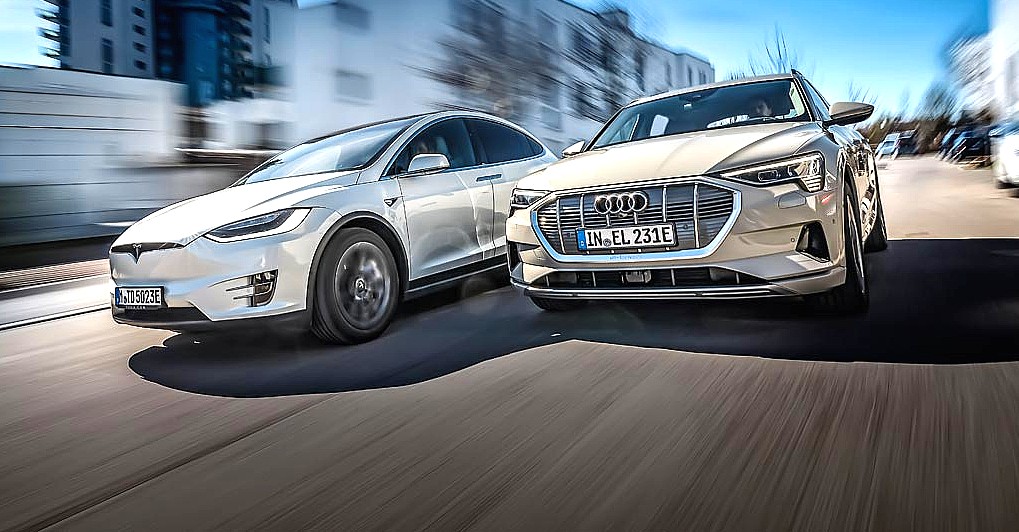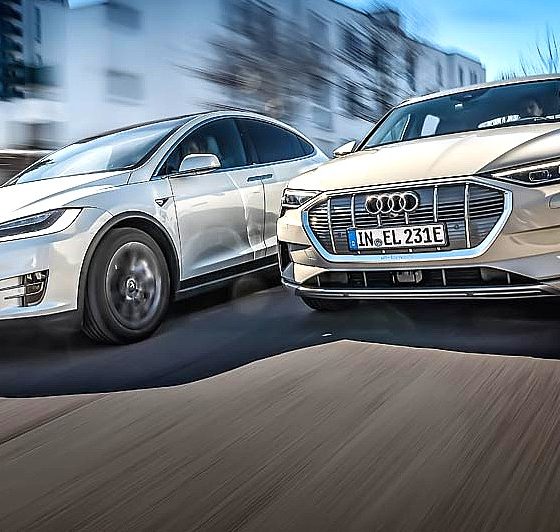

News
Audi e-tron will ‘give Tesla shoppers a run for their money,’ says Consumer Reports
When Consumer Reports published its first impressions of the Audi e-tron, the organization proved quite optimistic about the German carmaker’s all-electric SUV. In a recently uploaded video, Consumer Reports‘ Mike Quincy, Jon Linkov, and Jennifer Stockburger provided more insights about their experience with the e-tron, covering several aspects of the vehicle such as its design, its range, and how it stacks up in comparison to the Tesla Model X.
Consumer Reports auto journalist Mike Quincy praised the vehicle, noting that the Audi e-tron is the “nicest EV I’ve ever driven” to date. “I like it more than any of the Teslas we’ve driven,” he said. The e-tron also earned some applause for its design, such as its rather conventional interior that follows the theme of Audi’s other vehicles. The SUV’s spaciousness and quietness on the road were also lauded.
The driving dynamics of the vehicle also received some praise, with Director of Operations at the CR Auto Test Center Jennifer Stockburger noting that the SUV performs very well as soon as it’s in motion. Commenting further, Consumer Reports Deputy Content Editor Jon Linkov stated that contrary to the snap of acceleration found in Tesla’s electric cars like the Model S, the Audi e-tron has “more of an elegant pull-away.”
Consumer Reports did have a number of negative comments about the e-tron, particularly on its range and price. At $80,000, Quincy noted that the e-tron seems too expensive for a vehicle that features such a limited range, though it was mentioned that perhaps the SUV’s real-world range was being underestimated. Other quirks of the SUV, such as a gear shifter that is a magnet for wrong inputs, were also mentioned as points for improvement. Linkov, for his part, argued that perhaps the limited range of the e-tron would be a non-issue for its target demographic.
“It may be that the market for this doesn’t take family road trips. They may fly. Electric cars today still make a case, particularly $80,000 ones, for a second car. Now there are a lot of people out there, and there are stories online about people, they own a Chevy Bolt, or they own a Leaf, and that’s their only car, and they still run into those headaches of ‘my gosh, I have to stop and charge it’ and it certainly is a case today depending on what you want out of an electric car,” he said.
In conclusion, Consumer Reports remained quite optimistic about the e-tron’s chances on the market, particularly as it is coming from a well-known company that’s known for good quality vehicles. This, according to Stockburger, is something that Tesla buyers might not have yet. “Do I think it’s gonna give Tesla shoppers a run for their money? Oh yeah. And I think there’s a confidence to be had from a mainstream manufacturer building this car, one with a ton of history, good quality, and I think there might be some confidence in the e-tron that maybe you don’t have in a Tesla,” she said.
Curiously enough, several updates on the e-tron remain unsaid in Consumer Reports‘ recent video, such as the ongoing recall for the SUV due to a potential fire risk. The range challenges of the e-tron have also been documented extensively, even by foreign organizations such as nextmove from Germany; and so far, reviews of the SUV which concluded that the vehicle’s range is being underestimated seem to be quite scarce.
The comparisons with the Model X also seemed quite interesting, considering that there was no mention of the recent update that Tesla rolled out into the SUV, which increased its range to 325 miles per charge using a battery that is only 5 kWh larger than the pack utilized by the e-tron. Long trips in an all-electric car have been addressed for years by the Supercharger Network, which allows Tesla’s vehicles to recharge their batteries during quick stops on the road.
Watch Consumer Reports‘ discussion on its Audi e-tron first impressions in the video below.

News
Tesla FSD fleet is nearing 7 billion total miles, including 2.5 billion city miles
As can be seen on Tesla’s official FSD webpage, vehicles equipped with the system have now navigated over 6.99 billion miles.

Tesla’s Full Self-Driving (Supervised) fleet is closing in on almost 7 billion total miles driven, as per data posted by the company on its official FSD webpage.
These figures hint at the massive scale of data fueling Tesla’s rapid FSD improvements, which have been quite notable as of late.
FSD mileage milestones
As can be seen on Tesla’s official FSD webpage, vehicles equipped with the system have now navigated over 6.99 billion miles. Tesla owner and avid FSD tester Whole Mars Catalog also shared a screenshot indicating that from the nearly 7 billion miles traveled by the FSD fleet, more than 2.5 billion miles were driven inside cities.
City miles are particularly valuable for complex urban scenarios like unprotected turns, pedestrian interactions, and traffic lights. This is also the difference-maker for FSD, as only complex solutions, such as Waymo’s self-driving taxis, operate similarly on inner-city streets. And even then, incidents such as the San Francisco blackouts have proven challenging for sensor-rich vehicles like Waymos.
Tesla’s data edge
Tesla has a number of advantages in the autonomous vehicle sector, one of which is the size of its fleet and the number of vehicles training FSD on real-world roads. Tesla’s nearly 7 billion FSD miles then allow the company to roll out updates that make its vehicles behave like they are being driven by experienced drivers, even if they are operating on their own.
So notable are Tesla’s improvements to FSD that NVIDIA Director of Robotics Jim Fan, after experiencing FSD v14, noted that the system is the first AI that passes what he described as a “Physical Turing Test.”
“Despite knowing exactly how robot learning works, I still find it magical watching the steering wheel turn by itself. First it feels surreal, next it becomes routine. Then, like the smartphone, taking it away actively hurts. This is how humanity gets rewired and glued to god-like technologies,” Fan wrote in a post on X.
News
Tesla starts showing how FSD will change lives in Europe
Local officials tested the system on narrow country roads and were impressed by FSD’s smooth, human-like driving, with some calling the service a game-changer for everyday life in areas that are far from urban centers.

Tesla has launched Europe’s first public shuttle service using Full Self-Driving (Supervised) in the rural Eifelkreis Bitburg-Prüm region of Germany, demonstrating how the technology can restore independence and mobility for people who struggle with limited transport options.
Local officials tested the system on narrow country roads and were impressed by FSD’s smooth, human-like driving, with some calling the service a game-changer for everyday life in areas that are far from urban centers.
Officials see real impact on rural residents
Arzfeld Mayor Johannes Kuhl and District Administrator Andreas Kruppert personally tested the Tesla shuttle service. This allowed them to see just how well FSD navigated winding lanes and rural roads confidently. Kruppert said, “Autonomous driving sounds like science fiction to many, but we simply see here that it works totally well in rural regions too.” Kuhl, for his part, also noted that FSD “feels like a very experienced driver.”
The pilot complements the area’s “Citizen Bus” program, which provides on-demand rides for elderly residents who can no longer drive themselves. Tesla Europe shared a video of a demonstration of the service, highlighting how FSD gives people their freedom back, even in places where public transport is not as prevalent.
What the Ministry for Economic Affairs and Transport says
Rhineland-Palatinate’s Minister Daniela Schmitt supported the project, praising the collaboration that made this “first of its kind in Europe” possible. As per the ministry, the rural rollout for the service shows FSD’s potential beyond major cities, and it delivers tangible benefits like grocery runs, doctor visits, and social connections for isolated residents.
“Reliable and flexible mobility is especially vital in rural areas. With the launch of a shuttle service using self-driving vehicles (FSD supervised) by Tesla in the Eifelkreis Bitburg-Prüm, an innovative pilot project is now getting underway that complements local community bus services. It is the first project of its kind in Europe.
“The result is a real gain for rural mobility: greater accessibility, more flexibility and tangible benefits for everyday life. A strong signal for innovation, cooperation and future-oriented mobility beyond urban centers,” the ministry wrote in a LinkedIn post.
News
Tesla China quietly posts Robotaxi-related job listing
Tesla China is currently seeking a Low Voltage Electrical Engineer to work on circuit board design for the company’s autonomous vehicles.

Tesla has posted a new job listing in Shanghai explicitly tied to its Robotaxi program, fueling speculation that the company is preparing to launch its dedicated autonomous ride-hailing service in China.
As noted in the listing, Tesla China is currently seeking a Low Voltage Electrical Engineer to work on circuit board design for the company’s autonomous vehicles.
Robotaxi-specific role
The listing, which was shared on social media platform X by industry watcher @tslaming, suggested that Tesla China is looking to fill the role urgently. The job listing itself specifically mentions that the person hired for the role will be working on the Low Voltage Hardware team, which would design the circuit boards that would serve as the nervous system of the Robotaxi.
Key tasks for the role, as indicated in the job listing, include collaboration with PCB layout, firmware, mechanical, program management, and validation teams, among other responsibilities. The role is based in Shanghai.
China Robotaxi launch
China represents a massive potential market for robotaxis, with its dense urban centers and supportive policies in select cities. Tesla has limited permission to roll out FSD in the country, though despite this, its vehicles have been hailed as among the best in the market when it comes to autonomous features. So far, at least, it appears that China supports Tesla’s FSD and Robotaxi rollout.
This was hinted at in November, when Tesla brought the Cybercab to the 8th China International Import Expo (CIIE) in Shanghai, marking the first time that the autonomous two-seater was brought to the Asia-Pacific region. The vehicle, despite not having a release date in China, received a significant amount of interest among the event’s attendees.








